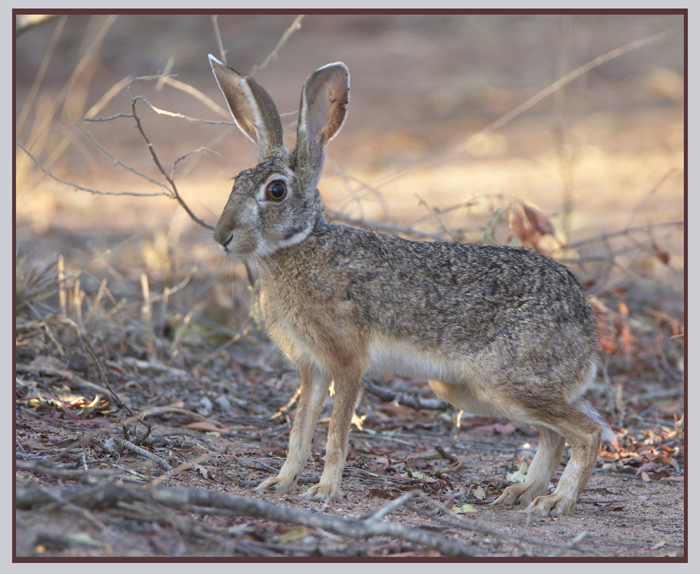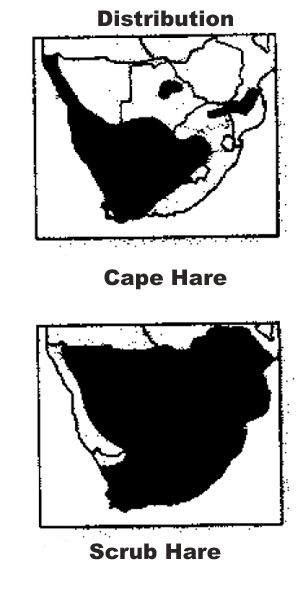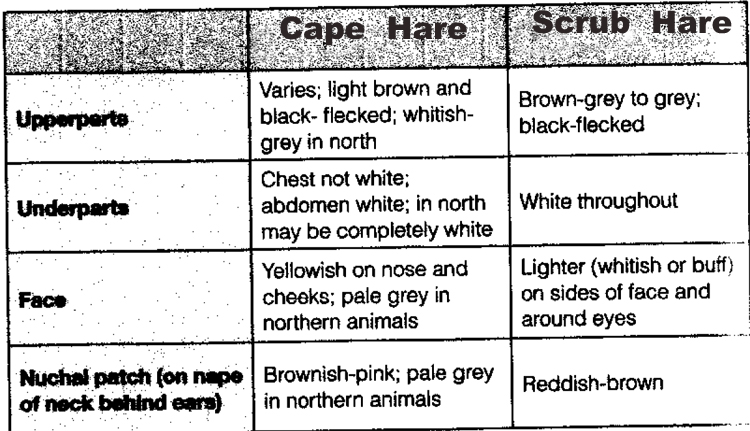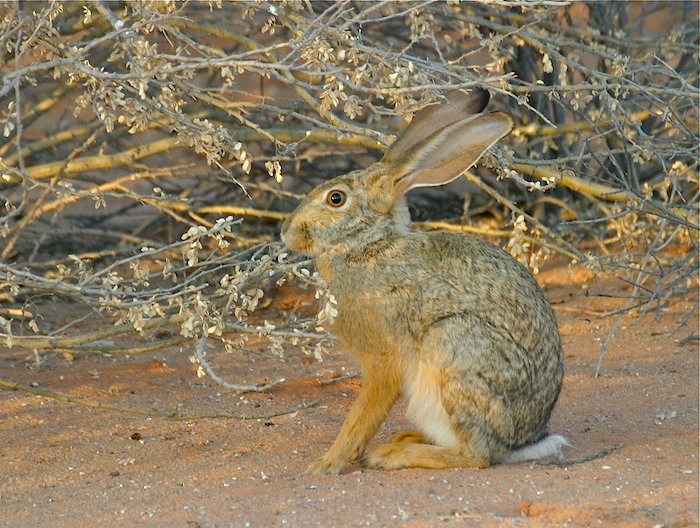PLEASE post any pics you may have of scrub hares here, no matter what park or otherwise.
***********************
Scrub Hare - Lepus saxatilis

Geographic Range
Native to the continent of Africa, and there have been no reported attempts to introduce it into other areas. It is primarily found throughout Southern Africa and Namibia, with the exception of the Namib Desert. It has also been found in other African locations, including Nigeria extending westward to Southwest Mauritana and Senegal, Southeast Ethiopia, Uganda, most of Kenya, Angola, Zambia, Malawi and Mozambique.
Habitat
Found at elevations of 1220 to 1830 m above sea level. The species is primarily found in the savanna woodland and scrub areas of Africa.
Description
Can be identified by its complex fur coloration pattern. Its dorsal fur is grizzled gray and often has tiny black spots, while its ventral fur is white. It has a multicolored tail that is black on top and white underneath. It has lighter fur on the sides of its face and around its eyes. Many have a white patch of fur on their forehead and also has a patch of reddish-brown fur behind its ears.
Exhibits a large range in both its body size and mass. Length ranges from 45 cm to 65 cm, and mass ranges from 1500 g to 4500 g. This range in body size follows a geographic pattern, such that there is a decrease in body size when moving from the North to the South of its range. This same geographic pattern can be observed with ear length. In any particular area, females typically have a larger body length and mass than do males (Sexual Dimorphism).
Its hind legs are much longer than its forelegs, and its hind feet have a lighter fur color than its forefeet. All of its feet are heavily furred.
Reproduction
This species is apparently polygynous and is normally solitary. However, when a female is experiencing oestrus, multiple males will often remain near her.
It breeds throughout the year, despite frequent droughts and dry conditions. Its peak-breeding season is during the African summer (from September to February) when the climate is warmer and wetter. Fertilization is internal, and the gestation period lasts an average of 42 days. A female may give birth to 1 to 3 young. Females more frequently give birth to triplets following rainy seasons rather than dry seasons.
The leverets are born with all of their hair and their eyes open. The average mass at birth is 115 grams. Shortly after birth, the young will be capable of moving around and providing for itself. There is little parental care, and it is usually limited to a single suckling period during the night. This occurs each night until the leverets are weaned, however the number of days it takes for the leverets to be weaned is not known. No nest is made for the leverets. Although many leverets will not survive their first year, the ones that do survive will be sexually mature after this year.
Lifespan/Longevity
Frequently does not survive its first year. Although details of its lifespan are limited, close relatives within the genus Lepus have been know to live up to five years in the wild.
Behavior
The species is nocturnal and emerges at sundown to forage. Occasionally, if the sky is overcast, it will forage during the morning or afternoon. During the day, they rest in forms, which are indentations in the ground that it makes with the pressure of its body. An individual will usually return to the same form for multiple days unless disturbed, at which point it is forced to create another. Within these forms, it is disguised from its predators due to its cryptic coloration, which blends in with the vegetation and scrub land. By minimizing movement, these animals are much less likely to be detected by predators. It also keeps its long ears folded back over its shoulders to avoid identification by predators. It hesitates until the last possible moment and then evacuates at an incredible rate.
At one point during the day, they excrete a Vitamin B-rich pellet and then ingests it. The function of this behavior is not known.
Food Habits
Primarily a folivore. It has a preference for the green grass that grows during the wetter and cooler climates. However it will also eat the leaves, stems and rhizomes of grass that grows during dryer climate periods. Members of the genus Lepus will occasionally indulge in shrub bark if there is no other food source available.
Being nocturnal, it does the majority of its foraging either during or after sunset. It has occasionally been seen foraging during the early mornings or afternoons when the sky is overcast, but this is less frequent.
Predation
Side-striped jackals are a common predator.
Ecosystem Roles
Has multiple roles within the ecosystem. It is responsible for a minimal amount of soil aeration, as it helps to break up the ground and redistribute the soil when creating its forms. It influences vegetational growth, and serves as prey for larger animals.
It also serves as a host for multiple flea and lice species.
Conservation Status
It is not listed as endangered and its population remains widespread throughout Africa.





 Kalahari
Kalahari